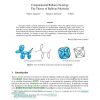Free Online Productivity Tools
i2Speak
i2Symbol
i2OCR
iTex2Img
iWeb2Print
iWeb2Shot
i2Type
iPdf2Split
iPdf2Merge
i2Bopomofo
i2Arabic
i2Style
i2Image
i2PDF
iLatex2Rtf
Sci2ools
CCCG
2008
2008
Computational Balloon Twisting: The Theory of Balloon Polyhedra
This paper builds a general mathematical and algorithmic theory for balloon-twisting structures, from balloon animals to balloon polyhedra, by modeling their underlying graphs (edge skeleta). In particular, we give algorithms to find the fewest balloons that can make exactly a desired graph or, using fewer balloons but allowing repeated traversal or shortcuts, the minimum total length needed by a given number of balloons. In contrast, we show NP-completeness of determining whether such an optimal construction is possible with balloons of equal length. What if Euler were a clown? (a) Classic dog (one balloon). (b) Octahedron (one balloon). Figure 1: Two one-balloon constructions and their associated graphs.
| Added | 29 Oct 2010 |
| Updated | 29 Oct 2010 |
| Type | Conference |
| Year | 2008 |
| Where | CCCG |
| Authors | Erik D. Demaine, Martin L. Demaine, Vi Hart |
Comments (0)

